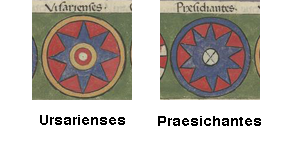
This page created 13 May 2014, and last modified: 23 September 2015 (Jones commentary added)

The 20th of the 32 units of legiones comitatenses listed (98/9.117 in Ingo Maier's numbering scheme) in the Magister Peditum's infantry roster is called the Praesichantes; it is assigned (102/5.138) to the Magister Equitum's Gallic command as the Praesidienses. Its shield pattern (96#10), as shown in various manuscripts under the label (96.k) Praesidienses (Praesidiantes in P), is as below:

The pattern shows a white boss (quartered in O, P, W; plain in M, B), a red ground, and an indigo rim (purple in B; faded to maroon in M; white in W); most of the red is overlain by an indigo star (purple in B; faded to maroon in M, W) of 10 (O, P, M), 11 (W) or 16 points (B) reaching (except in O) to the rim. It thus looks somewhat similar to the next unit in the Magister Peditum's list, the Ursarienses (98/9.118), as can be seen by comparing their patterns, using the appropriate Parisian manuscript (P) pictures, as shown below:

Both of these units are assigned to the Magister Equitum's Gallic command, although in his list, the Ursarienses come first, and the "Praesichantes" are called the Praesidienses, which must be considered as the true spelling (the two look much closer in medieval handwriting than they do in modern printed fonts). "Praesichantes" seems to have no known meaning, while "Praesidium" means, among other things, both "garrison" and "headquarters", and several localities around the Roman empire can be found bearing the name (note that in the Paris manuscript, P, the shield label is Praesidiantes, half-way between the two).
The Praesidienses may simply have taken its name from the unit's job description, being a garrison, but more likely is to be identified more indirectly with a headquarters, through a locality called Praesidio/Praesidium, such as that listed under the Dux Britanniarum as being the station of a Praefectus equitum Dalmatarum (154.3). A British connection is not implausible, but there is no direct evidence for it, either. If they did come from the British Praesidio, they had presumably been withdrawn from Britain earlier than most of the other British units that later found their way into the Gallic field force, as the Praesidienses had had time to be promoted from pseudocomitatenses to comitatenses in the intervening period.
Note that Jones considered the Praesidienses to be the same as the Auxilia Praesidentia (141.22) under the Dux Provinciae Pannoniae secundae ripariensis et Saviae. This is implausible, given it would require the unit to have been converted from an auxiliary unit to a legionary unit without changing its name, which would appear to be unprecedented. If the origins of the Praesidienses are not with the British Praesidio, it would appear to be more fruitful to look for some other Praesidium, with a legionary as opposed to an auxiliary garrison, as the origins of the unit.
It has been suggested that the British Praesidio can be equated with the provincial headquarters of York itself, and although there are formidable arguments against this, the location of Praesidio was clearly in the nearby area, and thus if the Praesidienses did originate from the British Praesidio, it would presumably have been a detachment of Legio VI victrix, which was the regular legion stationed at York. Of course, with so many other locations called Praesidium scattered around the empire, it is entirely possible the unit's origin lies elsewhere. Another example from the western half of the empire is the modern Burgo of Castro Caldelas, Galicia, Spain; another is Si Aioun in southern Tunisia. If the first of these is taken as the place or origin, the parent unit would be Legio VII gemina (156/8.44), headquartered at Legio (León); if the latter place, the parent unit would most likely be Legio III Augusta, the sole legionary unit in Africa for many years. Note that the African fort is very small however: epigraphic evidence (AE 1909.704) has been found within the fort for a mounted auxiliary detachment under a decurion, which would accord well with its 30 by 40 metre size.
The similarity of the shield patterns of the Praesidienses and the Ursarienses, together with their interchangeable list positions, would indicate they were likely a brigaded pair of units.
1. Maier, Ingo; "Appendix 4: Numeration of the new edition of the compilation 'notitia dignitatum' (Cnd)"; last accessed 7 December 2015. See also for here for numbering examples. Return
2. Jones, A.H.M.; "The Later Roman Empire, 284-602; A Social, Economic, and Administrative Survey"; Blackwell, Oxford, 1964 (3 volumes); at p 365 of vol. 3. Return
3. Rivet, A.L.F.; Smith, Colin; "The Place-Names of Roman Britain"; Batsford, London, 1979; at p 442. Return
4. Rivet, A.L.F.; Smith, Colin; "The Place-Names of Roman Britain"; Batsford, London, 1979; at p 157. Return

Return to the Notitia alphabetical unit list page.
Return to my Notitia index page.